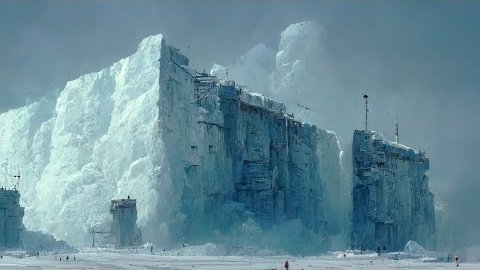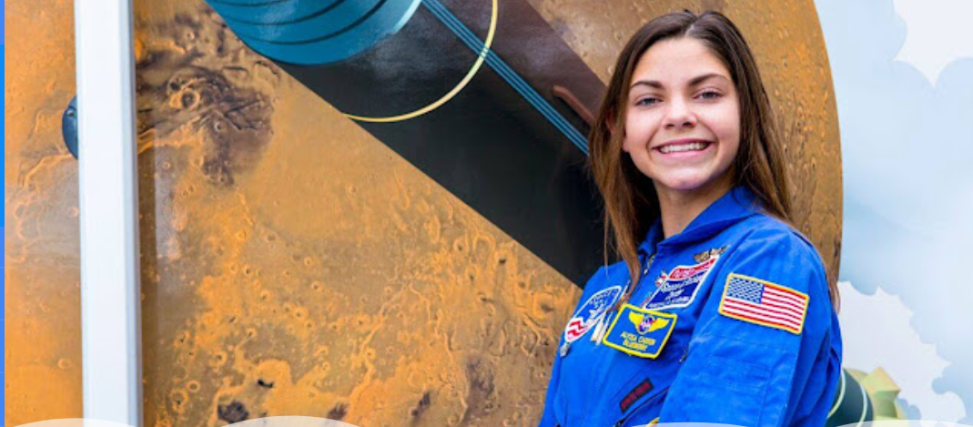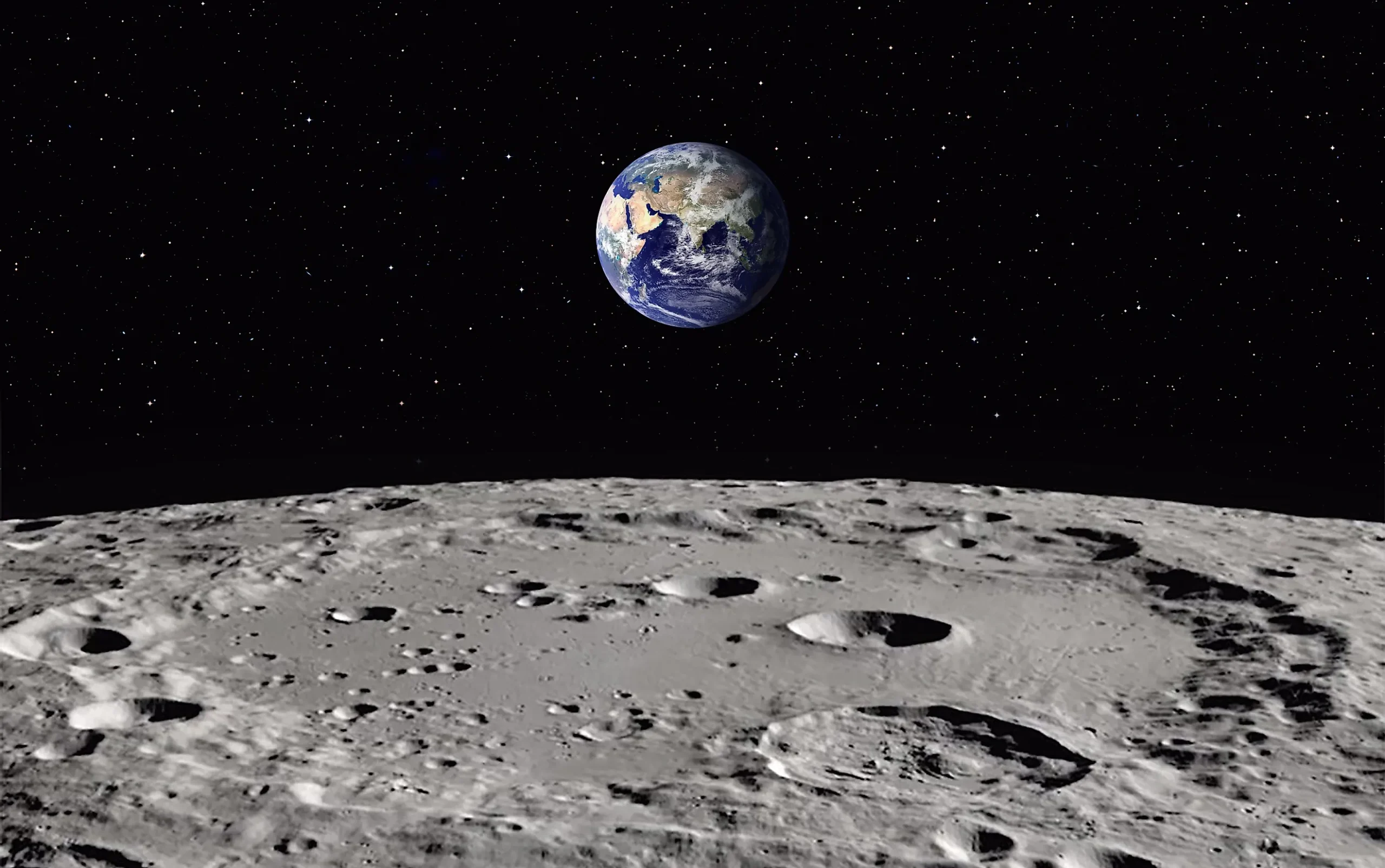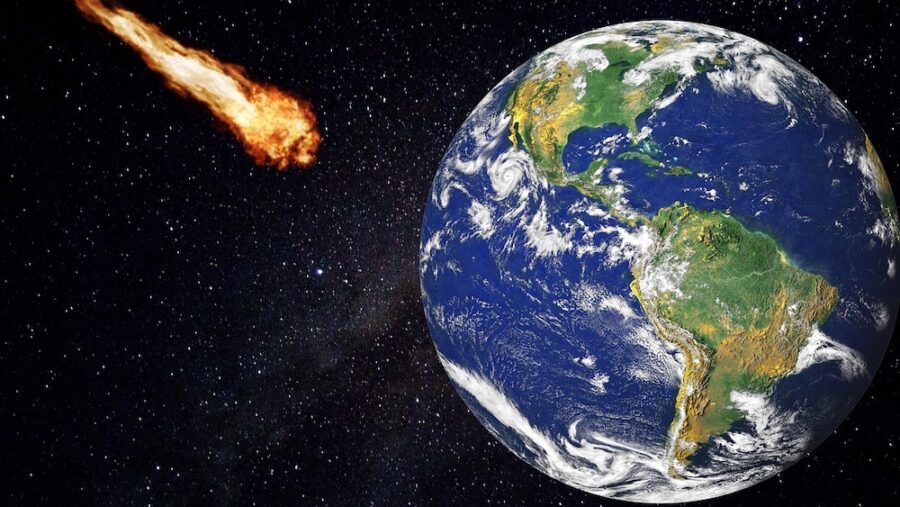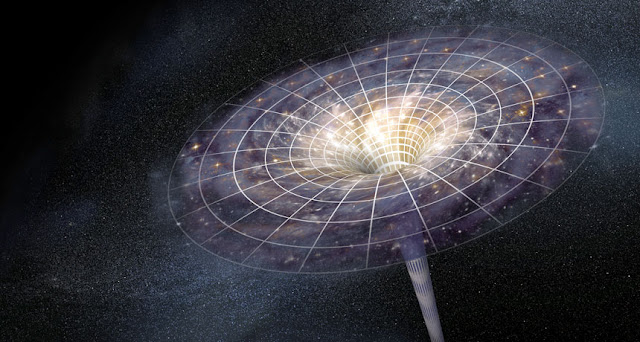On December 25, 2021, the world received the best Christmas gift as NASA’s James Webb Space Telescope commenced on the journey to unlock several mysteries of the Universe. Today is making it exactly one year since the most powerful Telescope of our time left our home planet for space. So, what has it accomplished so far? What next milestone should we be expecting the Webb Space Telescope to attain? Continue reading to find out.
What NASA’s James Webb Space Telescope Has Accomplished So Far
NASA’s James Webb Space Telescope was launched aboard the Ariane 5 space vehicle on December 25, 2021, from ESA’s launch site at Kourou in French Guiana, at 7:20 a.m. EST. NASA and its partners planned to use the Telescope to complement and extend the discoveries of the Hubble Space Telescope. The American space agency is also hoping to discover the first galaxies that formed in the early universe and also observe stars forming planetary systems.
The sophisticated obligations assigned to the Webb Space Telescope made the whole world to stood still and cheer the telescope as it left Earth for Space last Christmas. Webb gave us a promising future for our civilization embracing a new era of astronomy. So far, the telescope has performed exceptionally well and everyone is blown away by the fascinating infrared images it captured from space.
After the next generation space telescope was launched, the Webb team began to regulate the movement of the space vehicle carrying the telescope to space. On January 8, 2022, the team completely deployed the telescope’s 21-foot coated primary mirror.
“The successful completion of all of the Webb Space Telescope’s deployments is historic,” said Gregory L. Robinson, Webb program director at NASA Headquarters. “This is the first time a NASA-led mission has ever attempted to complete a complex sequence to unfold an observatory in space – a remarkable feat for our team, NASA, and the world.”
On Jan. 24, 2022, the Webb team fired the Telescope’s thrusters and carefully placed the space telescope into orbit around the Sun at the second Lagrange point, or L2. This point is Webb’s final destination, which is nearly 1 million miles from Earth.
“Webb, welcome home!” said NASA Administrator Bill Nelson upon the successful deployment of Webb in L2. “Congratulations to the team for all of their hard work ensuring Webb’s safe arrival at L2 today. We’re one step closer to uncovering the mysteries of the universe. And I can’t wait to see Webb’s first new views of the universe this summer!”
NASA decided to insert Webb into the orbit around the sun at the second Lagrange point to keep the telescope’s optics and other scientific instruments cold enough to operate accurately and capture the best view of the Universe.
After spending months in space, Webb captured its first image of the Cosmos. On July 11, 2022, Pres. Joe Biden previewed the first full-color image from Webb. This first image is the deepest and sharpest infrared image of the distant universe ever captured by a space telescope. Scientists named this image Webb’s First Deep Field, and it showed the image of a galaxy cluster called SMACS 0723. This comprises a cluster teeming with thousands of galaxies that consist of the faintest objects ever observed in the infrared.
On July 12, 2022, NASA released more images displaying the sophistication of all four of Webb’s start of the art scientific instruments. These images consist of the following.
SMACS 07023
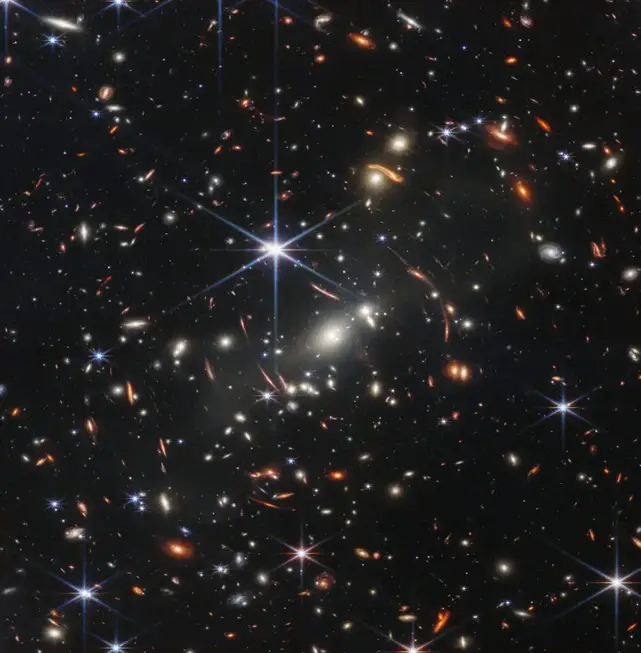 Image credit: NASA, ESA, CSA, and STScI
Image credit: NASA, ESA, CSA, and STScI
This image was released as Webb’s first Deep Field. It stands as the deepest and sharpest infrared image of the distant universe and was captured by Webb in only 12.5 hours. “For a person standing on Earth looking up, the field of view for this new image, a color composite of multiple exposures each about two hours long, is approximately the size of a grain of sand held at arm’s length,” NASA wrote in a statement describing the image.
This deep field image of the Webb takes advantage of the lensing galaxy cluster to discover some of the most distant galaxies spread across the Cosmos. NASA revealed that this deep field image only scratches the surface of Webb’s capabilities in analyzing deep fields and keeps tracing galaxies back to the beginning of Cosmic time. Hence, we should be expecting more mind-blowing deep-field images from the Webb, in the near future.
WASP-96b (Spectrum)

WASP-96b is a hot and puffy planet located outside our solar system. Webb’s detailed image of the planet reveals that this planet contains signs of water, evidence of haze, and clouds. Previous observations conducted on this planet could not detect any of these detailed descriptions of the Webb about the planet. Webb is currently focusing on studying the atmospheres of other exoplanets that made up our home galaxy.
Southern Ring Nebula
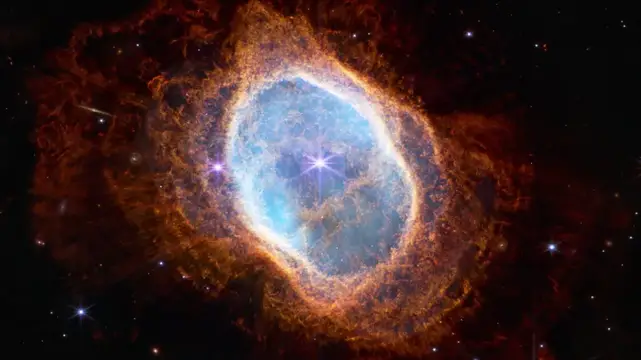
Image Credit: NASA, ESA, CSA, and STScI
Southern Ring Nebula is captured as an expanding cloud of gas surrounding a dying star. It is estimated to be approximately 2,000 light years away from Earth. Webb used its sophisticated infrared eyes to capture the second dying star in full view for the first time. NASA realized that the Webb could explore the expelling shells of dust and gas of age that may eventually form into a new star or planet someday in the future.
Stephan’s Quintet
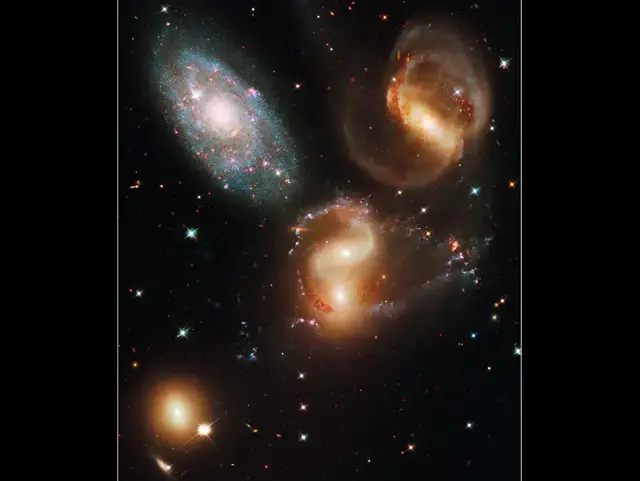
Image Credit: NASA, ESA, and the Hubble SM4 ERO Team
Webb also captured Stephan’s Quintet which is a compact group of galaxies located in the constellation Pegasus. This group of galaxies pierces through the shroud of dust encompassing the center of one galaxy to show the velocity and composition of the gas located close to its supermassive black hole.
This image enabled scientists to stare glance at a fascinating detailed view of how interacting galaxies are paving a way for star formation in each other. Scientists were also able to learn how the gas in each of these galaxies is being distributed from the image.
Carina Nebula
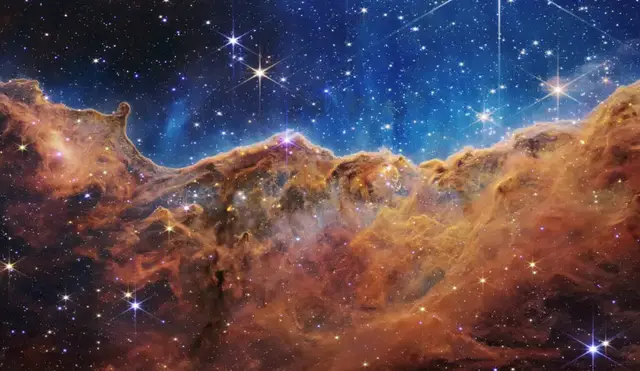
Image Credit: NASA, ESA, CSA, and STScI
Webb observed the Cosmic Cliffs located in the Carina Nebula and unveiled its earliest and rapid phases of star formation that have remained hidden from previous observations. The image shows a detailed view of the star-forming region in the southern constellation Carina. It also shows newly forming stars. Webb studied the gas and dust forming the stars in this region of the Universe.
Jupiter’s Aurora And Rings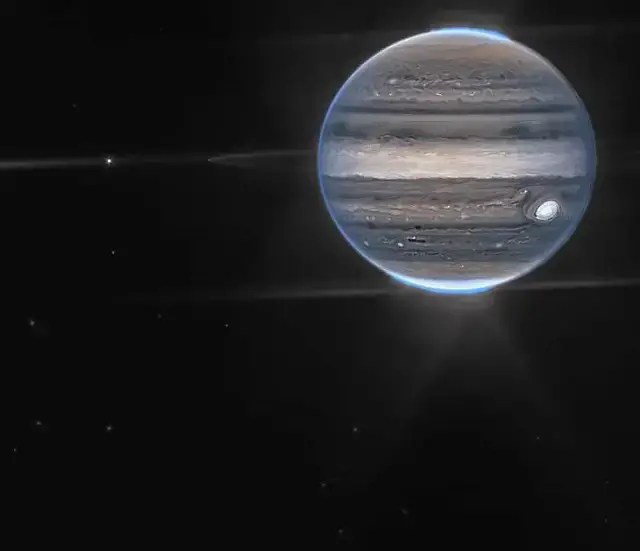
(Image credit: NASA, ESA, CSA, Jupiter ERS Team; image processing by Ricardo Hueso (UPV/EHU) and Judy Schmidt.)
On August 22, 2022, NASA released the latest image of Jupiter’s aurora as captured by the Webb space telescope. The new generation space telescope captured two images of Jupiter using its Near-Infrared Camera (NIRCam) which is made up of three specialized infrared filters that captured the fascinating detailed view of Jupiter.
“With giant storms, powerful winds, auroras, and extreme temperature and pressure conditions, Jupiter have a lot going on.” NASA wrote in an update, “Now, NASA’s James Webb Space Telescope has captured new images of the planet. Webb’s Jupiter observations will give scientists even more clues to Jupiter’s inner life.”
Planetary astronomer Imke de Pater, who is a professor emerita at the University of California, Berkeley also shared her option about the mind-blowing image of Jupiter as captured by the James Webb Space Telescope.
“We hadn’t really expected it to be this good, to be honest,” said planetary astronomer Imke de Pater, professor emerita of the University of California, Berkeley in a statement. “It’s really remarkable that we can see details on Jupiter together with its rings, tiny satellites, and even galaxies in one image,” she concluded.
Cartwheel Galaxy
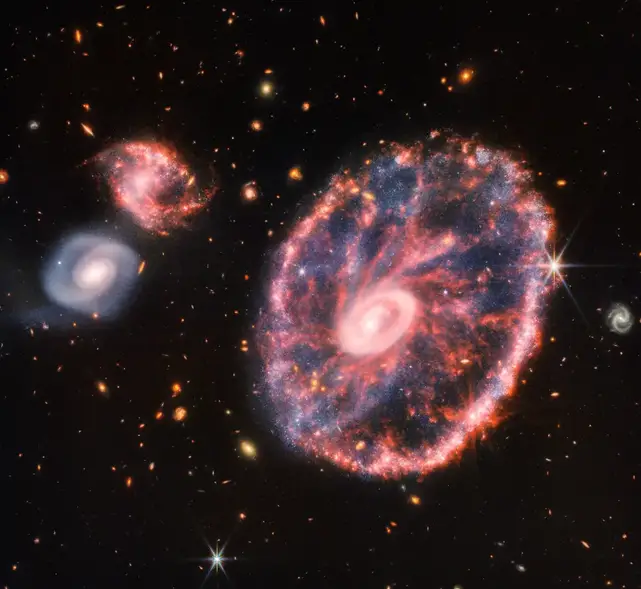 Credits: NASA, ESA, CSA, STScI
Credits: NASA, ESA, CSA, STScI
On August 2, 2022, NASA released the image of the Cartwheel Galaxy as captured by the James Webb Space Telescope. The sophisticated telescope looked deep into the chaos of the Cartwheel Galaxy and captured a detailed view of the galaxy. The image revealed new details about star formation in this region and also the galaxy’s central black hole. Webb used its powerful infrared gaze to produce the detailed image of the Cartwheel galaxy accompanied by two other smaller companion galaxies and many others. The image also shows how the Cartwheel Galaxy has changed over billions of years.
Tarantula Nebula
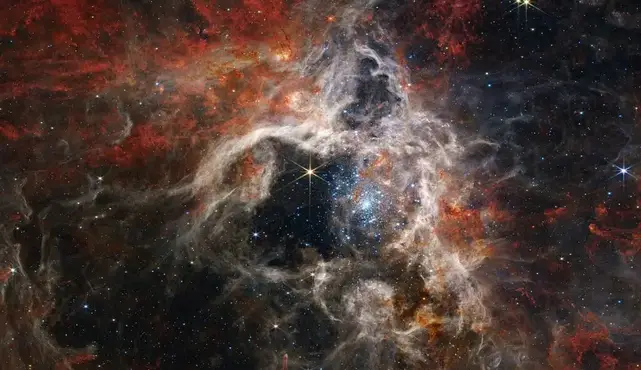
Image Credit: NASA, ESA, CSA, STScI, Webb ERO Production Team
Webb space telescope captured a fluffy tan-colored image of Tarantula nebula clouds which comprises rust-colored highlights surrounding a black central area. The black central area houses one large year star with eight long thin points which serve as the focal point of the image.
On the right of the image exists a bright star cluster that comes in an oval shape. The stars within the cluster appear like tiny pale blue sparkles. If you look at the bottom of the image, you will discover several arms that spread out taking the shape of a spider. The remaining dotted spots which spread across the image are stars and distant galaxies.
Neptune Rings
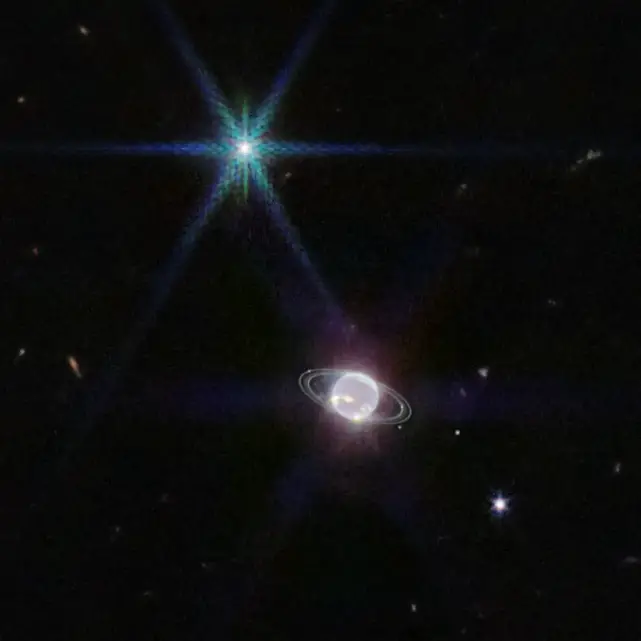
Webb also looked deep into the Solar system and captured a fascinating view of Neptune, its moons, and rings. Triton, Neptune’s moon captured by the Webb is the central focal point of this image. If you look closely, you can spot Neptune with its tiny rings around it. The black background is occupied by galaxies and stars. You can also spot a white spiral galaxy at the bottom of the image.
Wolf-Rayet 140

Image Credit: NASA, ESA, CSA, JWST, MIRI, ERS Program 1349; Processing: Judy Schmidt
On October 12, 2022, NASA released a new and mysterious image of at least 17 concentric dust rings coming from a pair of stars. These dust rings are located over 5,000 light years away from Earth. Scientists collectively named the rings Wolf-Rayet 140. Each one of these rings was created when the two stars came close to each other and their stellar winds (streams of gas released into space) collide. This collision compresses the gas and form dust.
“We’re looking at over a century of dust production from this system,” said Ryan Lau, an astronomer at NSF’s NOIRLab and lead author of a new study about the system, published today in the journal Nature Astronomy. “The image also illustrates just how sensitive this telescope is. Before, we were only able to see two dust rings, using ground-based telescopes. Now we see at least 17 of them.”
Pillar Of Creation
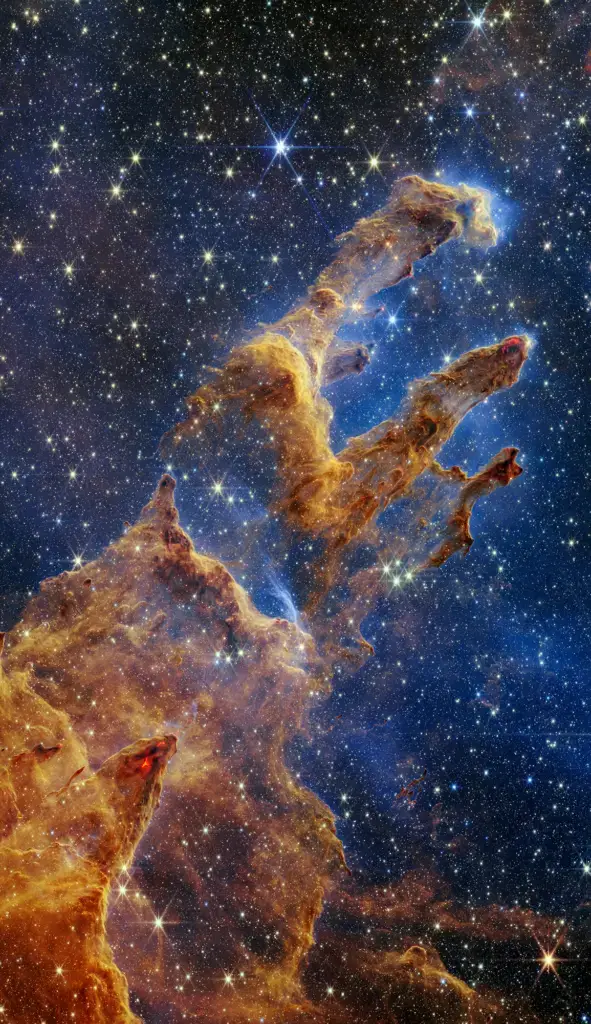
Image Credit: NASA, ESA, CSA, STScI
On October 28, 2022, NASA released a detailed view of the Pillar of creation as captured by the James Webb Space Telescope. Unlike the pillar of creation captured by the Hubble, this new image revealed more about the famous Cosmic pillars located in the Eagles Nebula. Webb also captured the ghost-looking version of these pillars.
Conclusion
NASA’s James Webb Space Telescope was able to make all these fascinating discoveries after exploring the Cosmos for only one year.
As the most powerful telescope of our time commences with its second year of exploring the Cosmos, we should be expecting more mind-blowing images of the Universe from it. Which of these Webb’s discoveries do you love most? Share your opinion in the commence session below.

